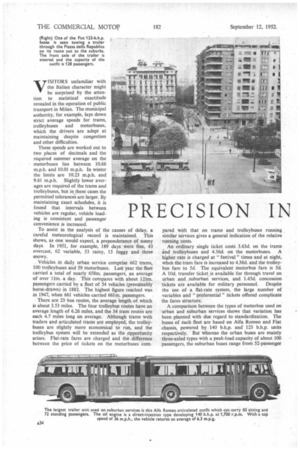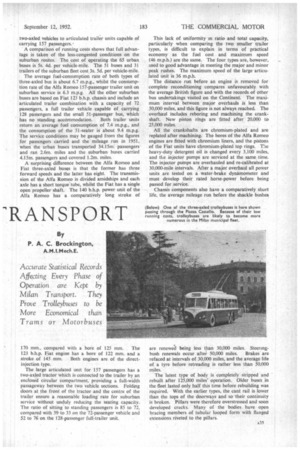PRECISION IN 'RAN SPORT
Page 52

Page 53

If you've noticed an error in this article please click here to report it so we can fix it.
By P. A. C. Brockington, A.M.t.Mech.E.
Accurate Statistical Records Affecting Every Phase of Operation are Kept by Milan Transport. They Prove Trolleybuses to be More Economical than Trains or Motorbuses VISITORS unfamiliar with the Italian character might be surprised by the attention to statistical exactitude revealed in the operation of public transport in Milan. The municipal authority, for example, lays down strict average speeds for trams, trolleybuses and motorbuses, which the drivers are adept at maintaining despite congestion and other difficulties.
These speeds are worked out to two places of decimals and the required summer average on the motorbuses lies between 10.66 m.p.h. and 10.01 m.p.h. In winter the limits are 10.23 m.p.h. and 9.61 m.p.h. Slightly lower averages are required of the trams and trolleybuses, but in these eases the permitted tolerances are larger. By maintaining exact schedules, it is found that intervals between vehicles are regular, vehicle loading is consistent and passenger convenience is increased.
To assist in the analysis of the causes of delay, a careful meteorological record is maintained. This shows, as one would expect, a preponderance of sunny days. In 1951, for example, 189 days were fine, 43 overcast, 62 variable, 53 rainy, 15 foggy and three snowy.
Vehicles in daily urban service comprise 662 trams, 100 trolleybuses and 59 motorbuses. Last year the fleet carried a total of nearly 658m, passengers, an average of over 1-Im. a day. This compares with about 12m. passengers carried by a fleet of 54 vehicles (presumably horse-drawn) in 1882. The highest figure reached was in 1947, when 661 vehicles carried 661m. passengers.
There are 23 bus routes, the average length of which is about 3.53 miles. The four troIleybus routes have an average length of 6.26 miles, and the 34 tram routes are each 4.7 miles long on average. Although trams with trailers and articulated trams are employed, the trolleybuses are slightly more economical to run, and the trolleybus system will be extended as the opportunity arises. Flat-rate fares are charged and the difference between the price of tickets on the motorbuses corn
pared with that on trams and trolleybuses running similar services gives a general indication of the relative running costs.
An ordinary single ticket costs 3.63d. on the trams and trolleybuses and 4.36d. on the motorbuses. A higher rate is charged at " festival " times and at night, when the tram fare is increased to 4.36d. and the trolleybus fare to 5d. The equivalent motorbus fare is 5d. A 10d. transfer ticket is available for through travel on urban and suburban services, and 1.45d. concession tickets are available for military personnel. Despite the use of a flat-rate system, the large number of variables and " preferential " tickets offered complicate the fares structure.
A comparison between the types of motorbus used on • urban and suburban services shows that variation has been planned with due regard to standardization. The buses of each fleet are based on Alfa Romeo and Fiat chassis, powered by 140 b.h.p. and' 123 b.h.p. units respectively. But whereas the urban buses are mainly three-axled types with a peak-load capacity of about 100 passengers, the suburban buses range from 52-passenger two-axled vehicles to articulated trailer units capable of carrying 157 passengers.• A comparison of running costs shows that full advantage is taken of the less-congested conditions on the suburban routes. The cost of operating the 65 urban buses is 5s. 4d. per vehicle-mile. The 51 buses and 31 trailers of the suburban fleet cost 3s. 5d. per vehicle-mile.
The average fuel-consumption rate of both types of three-axled bus is about 6.7 m.p.g., whilst the consumption rate of the Alfa Romeo 157-passenger trailer unit on suburban service is 6.3 m.p.g. All the other suburban buses are based on Fiat 123 b.h.p. chassis and include an articulated trailer combination with a capacity of 72 passengers, a full trailer vehicle capable of carrying 128 passengers and the small 51-passenger bus, which has no standing accommodation. Both trailer units return an average fuel consumption of 7.4 m.p.g., and the consumption of the 51-seater is about 9.4 m.p.g. The service conditions may be gauged from the figures for passengers carried and the mileage run in 1951, when the urban buses transported 34.15m. passengers and ran 2.6m. miles and the suburban buses carried 4.15m. passengers and covered 1.2m. miles.
A surprising difference between the Alfa Romeo and Fiat three-axled buses is that the former has three forward speeds and the latter has eight. The transmission of the Alfa. Romeo is divided amidships and each axle has a short torque-tube, whilst the Fiat has a single open propeller shaft. The 140 b.h.p. power unit of the Alfa Romeo has a comparatively long stroke of 170 mm., compared with a bore of 125 mm. The 123 b.h.p. Fiat engine has a bore of 122 mm. and a stroke of 145 mm. Both engines are of the directinjection type.
The large articulated unit for 157 passengers has a two-axled tractor which is connected to the trailer by an enclosed circular compartment, providing a full-width passageway between the two vehicle sections. Folding doors at the front of the tractor and the centre of the trailer ensure a reasonable loading" rate for suburban service without unduly reducing the seating capacity. The ratio of sitting to standing passengers is 85 to 72, compared with 39 to 33 on the 72-passenger vehicle and 52 to 76 on the 128-passenger full-trailer unit. This lack of uniformity in ratio and total capacity, particularly when comparing the two smaller trailer types, is difficult to explain in terms of practical economy as the fuel Cost and maximum speed (46 m.p.h.) are the same. The four types are, however, used to good advantage in meeting the major and minor peak rushes. The maximum speed of the large articulated unit is 36 m.p.h.
The distance run before an engine is removed for complete reconditioning compares unfavourably with the average British figure and with the records of other bus undertakings visited on the Continent. The maximum interval between major overhauls is less than 50,000 miles, and this figure is not always reached. The overhaul includes reboring and machining the crankshaft. New piston rings are fitted after 20,000 to 25,000 miles.
All the crankshafts are chromium-plated and are replated after machining. The bores of the Alfa Romeo engines are fitted with chromium liners, and the pistons of the Fiat units have chromium-plated top rings. The heavy-duty detergent oil is changed every 3,100 miles, and the injector pumps are serviced at the same time. The injector pumps are overhauled and re-calibrated at 30,000-mile intervals. After a major overhaul all power units are tested on a water-brake dynamometer and must develop their rated horse-power before being passed for service.
Chassis components also have a comparatively short life, the average mileage run before the shackle bushes are renewed being less than 30,000 miles. Steeringbush renewals occur after 50,000 miles. Brakes are refaced at intervals of 30,000 miles, and the average life of a tyre before retreading is rather less than 50,000 miles.
The latest type of body is completely stripped and rebuilt after 125,000 miles' operation. Older buses in the fleet lasted only half this time before rebuilding was required. With the earlier types, the cant rail is lower than the tops of the doorways and so their continuity is broken. Pillars were therefore overstressed and soon developed cracks. Many of the bodies. have open bracing members of tubular looped form with flanged extensions riveted to the pillars.




















































































